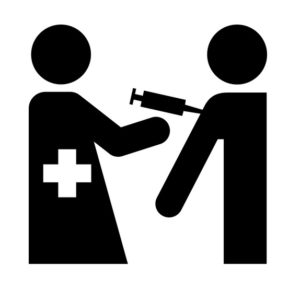 Real talk: Pediatrician’s offices are busier than I-65 southbound on the Friday of a holiday weekend. So, it might be that sometimes your questions go unanswered at the pediatrician’s office during your well child visit. You might forget to ask a question while you have those beautiful ten minutes with your pediatrician, or a term or phrase might pass in one ear and out of the other without you knowing exactly what it meant (thank you, Google) as your child screams to leave the office so she can go get ice cream. And then, sometimes, health care providers can start speaking and get carried away into an entirely different language . . . myself included. Whether you’re a brand new mom or a seasoned veteran, there are some terms and phrases used in the pediatrician’s office that might be lost in translation for you. You might be two or three kids into this motherhood thing and still not be quite sure of what a growth chart means or why your children have all gotten fever with one vaccine but not others.
Real talk: Pediatrician’s offices are busier than I-65 southbound on the Friday of a holiday weekend. So, it might be that sometimes your questions go unanswered at the pediatrician’s office during your well child visit. You might forget to ask a question while you have those beautiful ten minutes with your pediatrician, or a term or phrase might pass in one ear and out of the other without you knowing exactly what it meant (thank you, Google) as your child screams to leave the office so she can go get ice cream. And then, sometimes, health care providers can start speaking and get carried away into an entirely different language . . . myself included. Whether you’re a brand new mom or a seasoned veteran, there are some terms and phrases used in the pediatrician’s office that might be lost in translation for you. You might be two or three kids into this motherhood thing and still not be quite sure of what a growth chart means or why your children have all gotten fever with one vaccine but not others.
Whether you see your pediatrician once a year for a well-child checkup or if your sweet doctor sees you once a month with a snot-nosed kid, your relationship with him or her is so important. If you have a great relationship with your pediatrician and feel comfortable asking questions, that’s awesome and the way it should be! But if you forget to ask for clarification while you’ve got that precious but brief face-to-face time, let me decode just a few of the most frequently used terms related to your child’s health that you might hear in passing (then scratch your head about later).
Growth charts and percentiles
Throughout your visits to the pediatrician’s office, from birth to 18 years old, your child’s height and weight stats are plotted on a graph called a growth chart. Standard growth charts are published by the CDC (Centers for Disease Control and Prevention) and used by healthcare providers across the country. Where your child’s height and weight fall on the growth chart is indicative of how he or she compares to other children his age in relation to the national averages. The chart marks the most extreme heights and weights (both high and low), and then your pediatrician can mark where you child falls on the graph.
For example, if you have a three-year-old boy who weighs 28 pounds, your son is in between the 10-25th percentile for weight by age. This means that your child is heavier than 10-25% of other boys his age. Any percentile below 50% is on the smaller side of the scale, and any percentile larger than 50% is larger than others in the same peer group. HOWEVER, this doesn’t mean that because your child is in the 75th percentile for weight that he is overweight! It simply means that he is in the upper range of “normal”.
Really and truly, the important part of a growth chart for YOUR child is that while your child is growing and developing, their growth charts should remain stable. If your daughter’s weight and height for age has trended in the 80th percentile for most of her life and she’s suddenly in the 20th percentile, this could trigger your pediatrician to look into causes to her stunted growth. Similarly, if a child is skyrocketing off the growth chart for weight, a pediatrician will likely have a discussion regarding proper nutrition and healthy eating habits. With childhood obesity becoming a rapidly increasing epidemic across our nation, a growth chart can help demonstrate trends before weight gets too out of hand.
For examples of both boy and girl growth charts by ages, you can visit the CDC website.
Understanding vaccinations
Understanding vaccines your child might receive requires some basic knowledge of the immune system. In your blood stream, you have white blood cells (or WBCs) that fight off infections from bacteria or viruses. These WBCs can be trained to fight off specific viruses or bacteria before they proliferate and make you sick. Think: a WBC can find and destroy a single germ to keep you from becoming ill, similar to how your six-year-old daughter can find a single vegetable in a sea of marinara sauce and pick it out with her fork before finishing her meal.

Inactivated virus vaccines (such as hepatitis B, polio, and influenza) are a formulation of vaccine that include “dead” viruses that are unable to replicate. However, your immune system still recognizes them to be foreign and the source of a potential problem, so it attacks the virus and those smart little WBCs stay on the lookout for more viruses like them in future years. In live virus immunizations (such as chicken pox or MMR), the vaccine has a small amount of virus that is still alive. The same process happens when your WBCs attack and kill this virus. Live virus vaccinations activate and ramp up the immune system more so than inactive vaccinations, resulting in your baby possibly feeling fussy for a day or so while the immune system does its job.
The whole point of immunizations is to give your body a “heads up” about viruses that it might encounter in life such as measles, rubella, hepatitis, or chicken pox. Before vaccinations, a child could become very seriously ill or die from these common viruses that now have been all but eradicated from the mainstream population. The decision whether or not to vaccinate your child is an important topic to discuss openly and honestly with your pediatrician.
Developmental milestones
In addition to hitting appropriate height and weight marks, your child’s developmental milestones are an important part of your visits to the pediatrician’s office. Developmental milestones are like check points as your child grows to make sure they are accomplishing everything they need to grow up and function normally. You will be often asked if your child is “hitting all their milestones”, but what exactly are those milestones? And how do you know if you’ve missed one? Many pediatric offices have great resources that outline expected skills and behaviors at each age. Any generic google search for milestones at a certain age can give you a general idea of what your child should be able to do at a given time point in his or her life. These developmental milestones can be gross motor skills (such as walking or crawling), fine motor skills (eating with fingers, grasping objects), and social skills (speaking in sentences, sharing toys). 
Now, what if sweet baby girl isn’t rolling over by six months? Can your seven year old count by 10s? Is your three year old able to throw a ball overhanded? While your child might not be able to do EVERY thing on these developmental milestone lists, he or she should be able to meet several of these expectations at any given age. Fortunately, in pediatrics, there are fantastic programs and resources to help those children who need a little “push” in the developmental department. Programs like early intervention, physical therapy, or speech therapy are available (often in your very own school system! For free!) to help your child maximize his abilities and adapt to any disabilities they might have. The earlier these developmental delays are recognized, the more effective and helpful these intervention programs can be in getting your kid to his or her optimal functioning. Also, it’s important to know that if you child has a developmental delay, it’s just that: a DELAY. It does not necessarily mean your child will not achieve the milestone one day, just that he takes a little extra time to get there.
Keeping our tiny humans alive and thriving is arguably the most important job of motherhood, and knowing the ins and outs of the medical jargon that floats around your pediatrician’s office is helpful in better understanding how we can best help our children. Asking questions for clarification is not annoying or inappropriate during your doctor visits; in fact, it is encouraged and appreciated by your healthcare provider!
Do you have any questions about general health and wellness for your child? Any health concerns or topics you would like to see featured in another blog post? Email [email protected] with the subject line “Pediatric Health and Wellness”!











